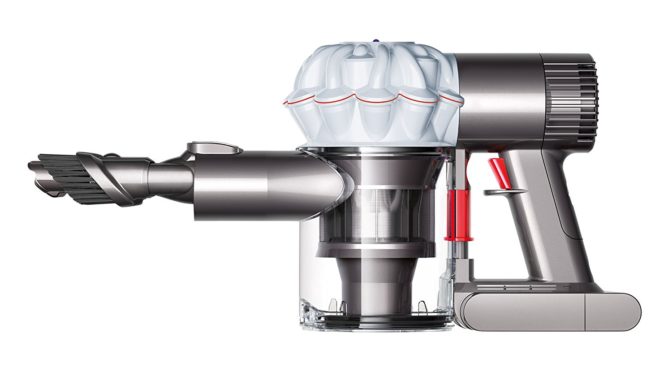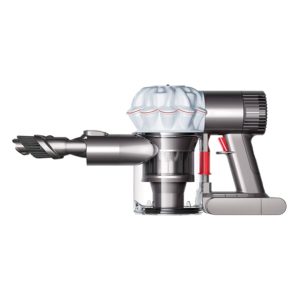
Even though upright and canister vacuums aren’t going anywhere any time soon, our contacts in the vacuum industry reflect the changes we’re seeing in homes around the country: people are buying fewer full-sized vacuums and more handhelds and robots. While portable and robotic vacuums don’t offer the power inherent to full-sized vacuums, they work well in many families as second or third vacuums when convenience trumps power.
Understanding this concept has brought Dyson to the forefront of the vacuum industry; it’s why they’ve got powerful uprights like the Ball Animal 2 as well as ultralights and handhelds like the V7 Car+Boat. Today we’re going to compare the Car+Boat to one of its previous generation cousins, the Dyson V6 Baby+Child Handheld Vacuum, to see which is the better deal for families with children. To summarize our thoughts in ten seconds, we’d recommend the V7 for greater battery life and more accessories and the V6 if you really want the wide nozzle tool. Our full review is below, and you can buy it here.
Pros, Cons, and Key Features of the Dyson V6 Baby+Child Handheld Vacuum
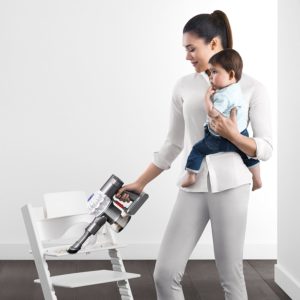
The Dyson V6 Baby+Child is one of at least half a dozen handheld vacuums Dyson has brought to market in recent years. The V7 generation only currently features the Car+Boat and Trigger, but the V6 generation brought us the Car+Boat, Baby+Child, Top Dog, Trigger, and Mattress, all of which are next to identical aside from differences in the accessories packed with each model. Frankly, we’d like to see fewer models and more differences between them, but we haven’t managed to gain a seat thus far at Dyson’s corporate headquarters. Maybe next year?
At any rate, key features for the V6 Baby+Child include 20 minutes of battery runtime, constant suction (the battery is designed to hold peak power levels until it runs out of charge), four tools including a wide-nozzle mattress tool, a hygienic dirt ejector, and 2 years of warranty coverage from Dyson. The V6 Baby+Child weighs 3.4 pounds on our scale and can generate 100 airwatts of suction. It has a .11 gallon capacity dust bin and requires 3.5 hours to fully charge its Lithium-ion battery.
When unboxing the V6, you’ll find the vacuum itself and four tools–a mattress tool, which is the most useful, a combination tool, crevice tool, and a stiff bristle brush. You’ll also get an AC charger.
What’s the difference between the Dyson V6 Baby+Child and the V7 Car+Boat?
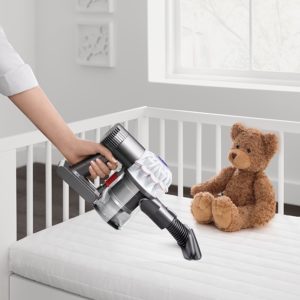
Because the V6 Baby+Child is one generation behind the V7 Car+Boat, there are naturally going to be some upgrades between the vacuums themselves, regardless of the accessory differences (which also exist). In our books, the additional features are worth moving from the Baby+Child to the Car+Boat if finances permit, or skipping the V6 entirely to buy the V7 if you’re deciding between the two.
The biggest difference lies in battery life: you move from 20 minutes with the V6 to 30 minutes with the V7, representing a 50% boost in usability. We noticed and appreciated this difference each time we tackled a decently large cleaning project, such as cleaning out the minivan or SUV, tidying up the nursery, or simply chasing dirt and dust bunnies throughout the house when we didn’t want to fish out the full-sized vacuum. You also get a 12 volt car charger with the Car+Boat, which allows you to partially charge the V7 whenever not actively using it to clean, such as while picking up odds and ends in your car. Frankly, it was a good move on Dyson’s part to add it.
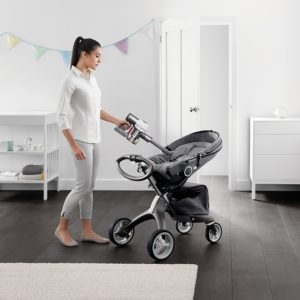
Besides battery and charger upgrades in the V7, we also liked the larger dust bin it included compared to the V6; a .15 gallon tank left more room for vacuuming dirt, pet hair, cereal, and other child and pet-related debris. The .11 gallon tank in the V6, while decent, had us running for the trash bins more frequently. The added battery life and dust collection do result in slightly more weight in the V7 at 3.8 pounds compared to 3.4 pounds in the V6. Practically speaking, both feel the same in your hands, and neither will make the difference between being able to clean while carrying a baby or not.
Similarly, power levels of both vacuums seemed exactly the same to us despite Dyson’s marketing of the V7 as their strongest handheld vacuum yet. It makes sense since both generations have the same maximum airwatt rating at 100. Something that was different, however, was the accessory list for both vacuums. The V7 does not include the mattress tool, but it does include every other tool in the V6 as well as a mini motorized tool, a mini soft dusting brush, and an extension hose. Because it was powered, the mini motorized tool was easily as useful as the mattress tool–more, actually–despite not being as wide. On top of this, we also appreciated the extension hose greatly in the Car+Boat, as it gave us several extra inches of reach for cleaning behind furniture and cabinetry. As a bonus, all the tools for the V7 come with quick release connections as well.
How useful is the Dyson V6 Baby+Child when cleaning vehicle interiors as well as around the house?
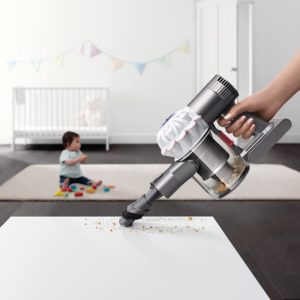
When buying a handheld vacuum, you’ll be happiest if you have grounded expectations. It’s not going to give you full-sized vacuuming power in a cordless package; you’re still going to need that Ball Animal 2 we mentioned earlier. If you want to clean high pile carpets, you’re going to want to keep that Miele Electro+. But if you’re looking for a machine that’s lightweight, portable, easy to hold in your hands, and strong enough to suck up crumbs, dirt, pet hair, dust, and a range of leftovers your kids leave in car seats, you’ll be happy with the Baby+Child. It’ll also take care of dirt and dust bunnies on counter tops, stairs, behind fridges, inside sofas and sectionals, and throughout your home and cars.
While it would have been nice to have had the additional 10 minutes of battery life built into the V7, we were able to make do with the 20 minutes available in the V6, and had we not known a similar-priced Dyson handheld existed with 30 minutes of battery life, we wouldn’t have missed it. That said, although we appreciated the cleaning radius of the mattress tool, we preferred the mini motorized tool and extension hose available in the Car+Boat and would gladly have swapped them for the additional tools in the Baby+Child that we didn’t use. We’d also have liked a shorter recharge time than 3.5 hours; even cheap robotic vacuums like the Shark Robot 750 or Roomba 690 only take 2-3 hours to charge. Dyson, the future is here!
Why buy the Dyson V6 Baby+Child?
Overall, the Baby+Child is a great vacuum. It’s easy to use, powerful for its size, and has a decent battery life. We’re also fans of the 2 year warranty and the sensible ergonomics. That said, we’d recommend buying the Car+Boat over the Baby+Child or any other V6 model just to take advantage of the boosts in battery life and the full set of accessories available in the Car+Boat. The motorized tool and extension hose in particular are worth the upgrades all by themselves.
![]() You can buy the Dyson V6 Baby+Child here on Amazon. If you want more battery life and better accessories, buy the Dyson V7 Car+Boat here instead.
You can buy the Dyson V6 Baby+Child here on Amazon. If you want more battery life and better accessories, buy the Dyson V7 Car+Boat here instead.
![]() Canadians can buy the Dyson V6 Baby+Child here on Amazon. If you want the upgraded features, buy the V7 Car+Boat here instead.
Canadians can buy the Dyson V6 Baby+Child here on Amazon. If you want the upgraded features, buy the V7 Car+Boat here instead.
 If you find our research on PMC helpful, you can follow our efforts to keep maniacally reviewing home cleaning tools by shopping through our links above. We promise to keep fighting the good fight against every horror children, animals, and grown, yet messy humans can inflict upon a clean home.
If you find our research on PMC helpful, you can follow our efforts to keep maniacally reviewing home cleaning tools by shopping through our links above. We promise to keep fighting the good fight against every horror children, animals, and grown, yet messy humans can inflict upon a clean home.

